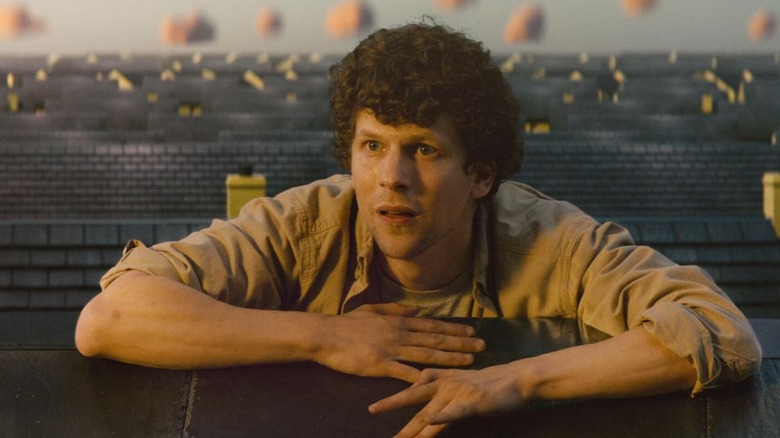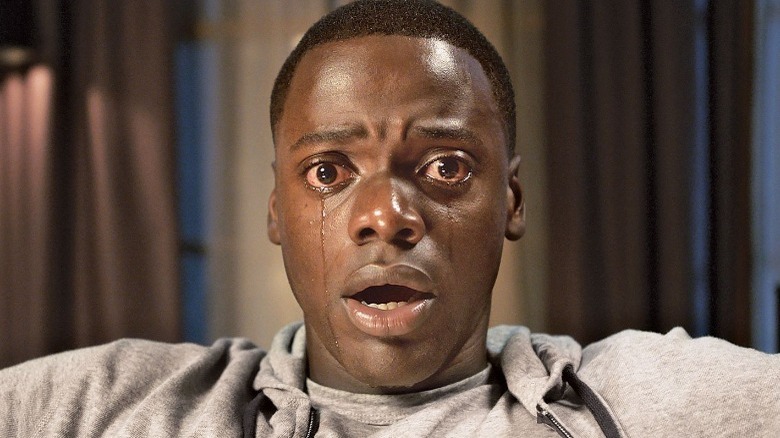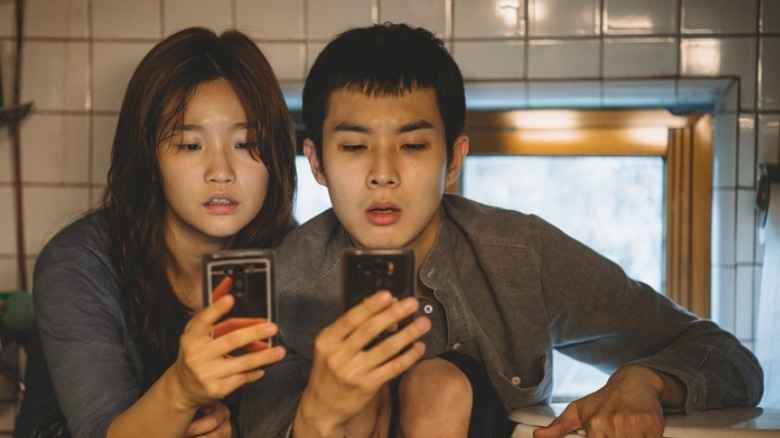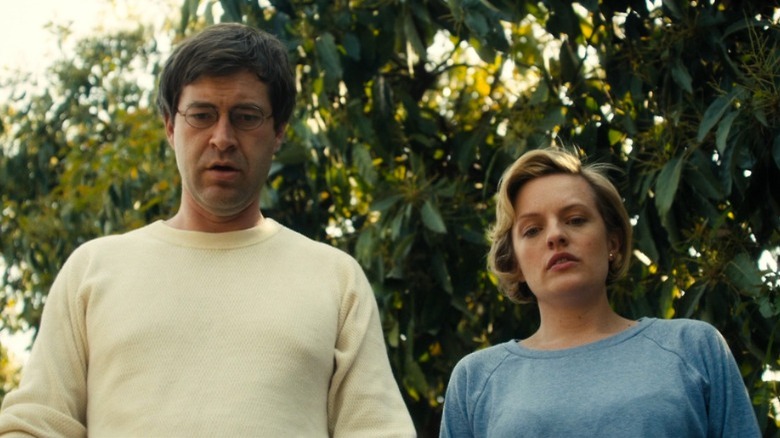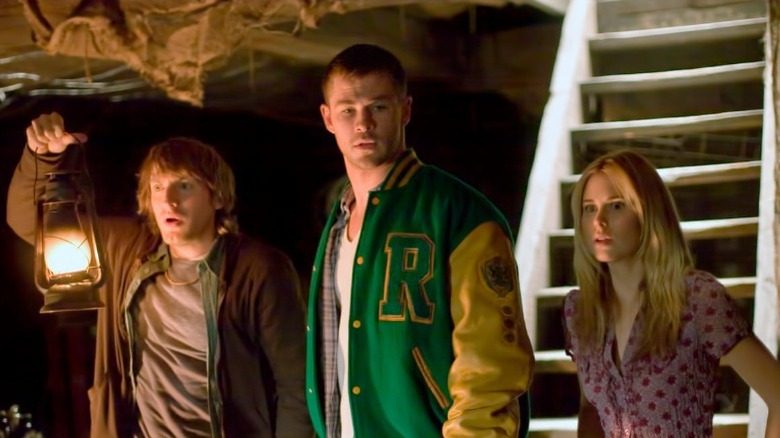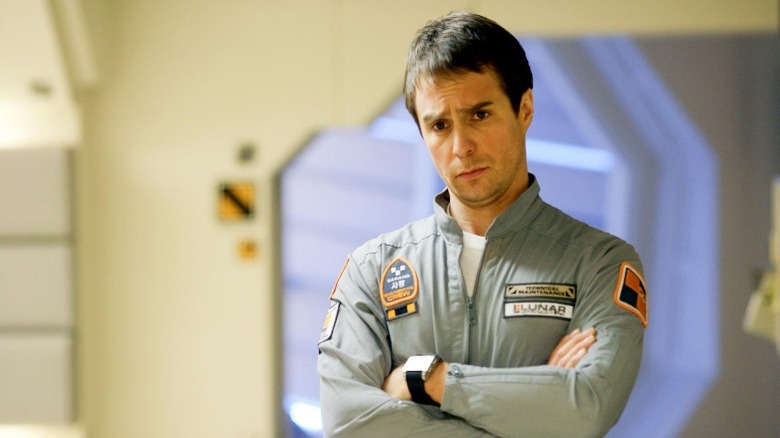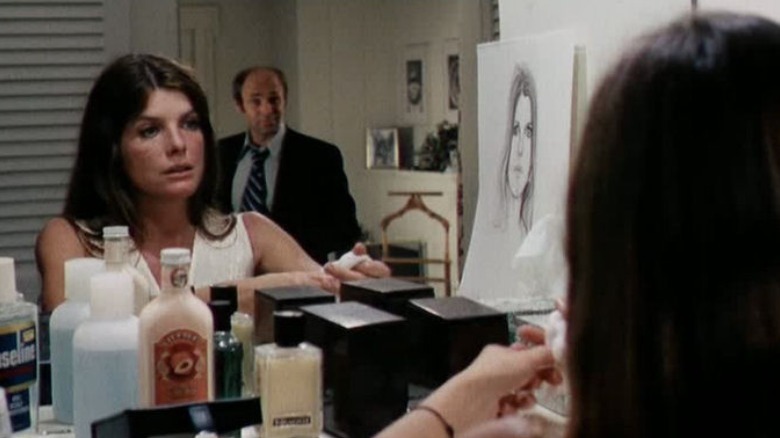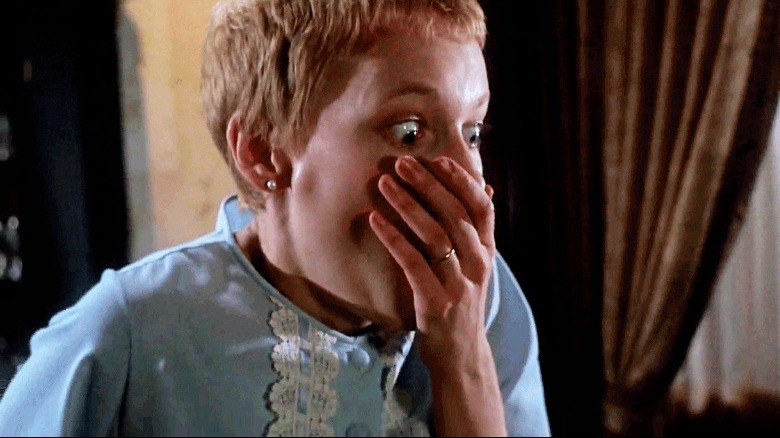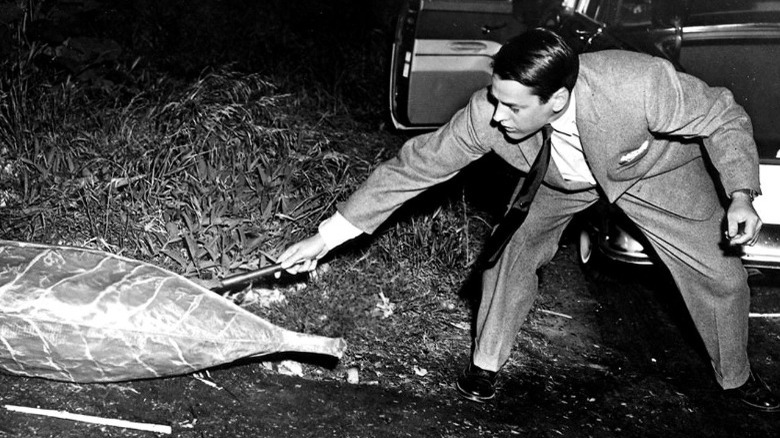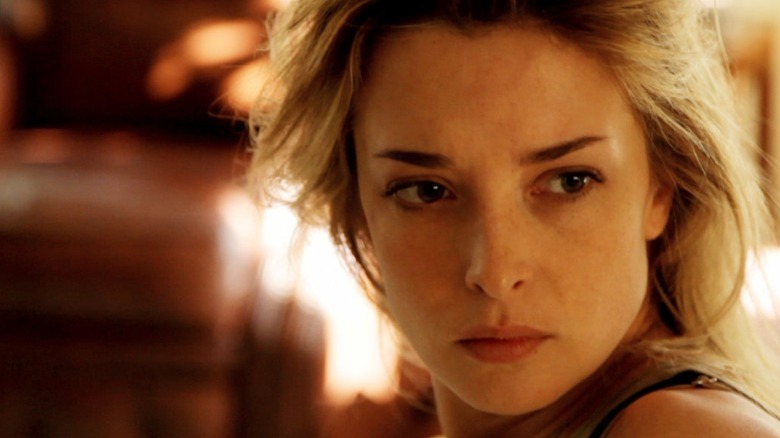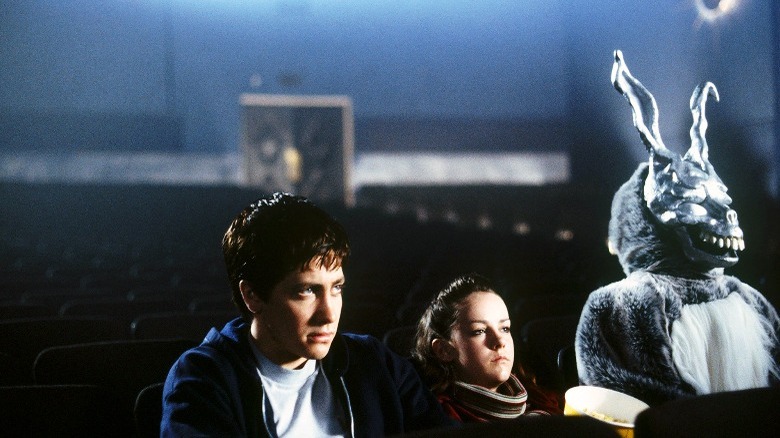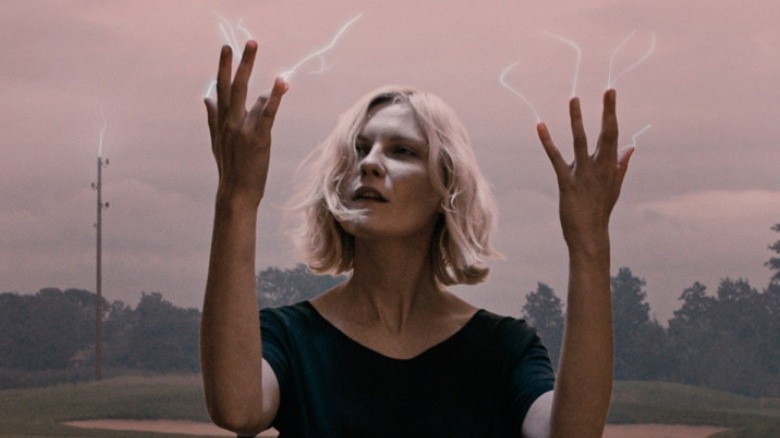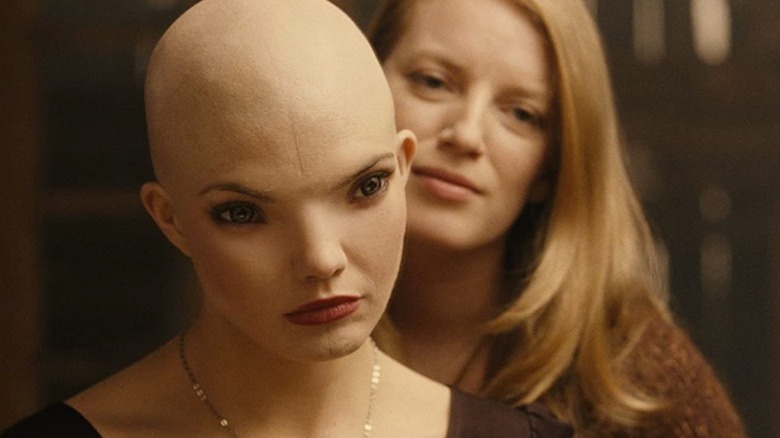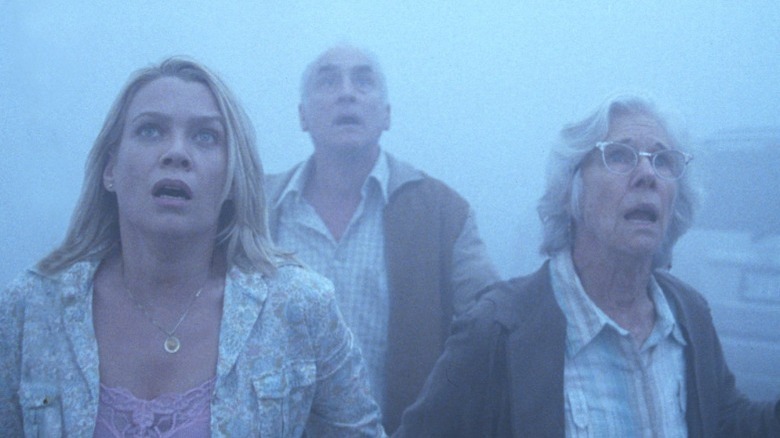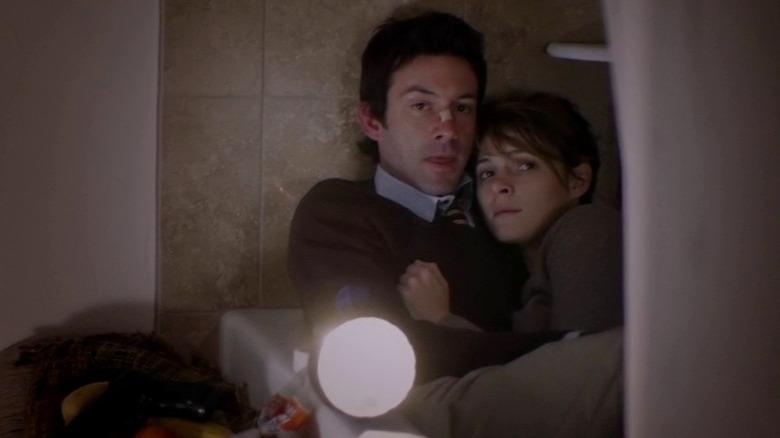15 Movies Like Vivarium That Sci-Fi Fans Need To See
If you missed "Vivarium" in the theater, you're not alone. It was released on VOD and "in theaters" on March 27th, 2020, which is to say a few scattered theaters in foreign countries, as nearly every movie theater in the U.S. was closed under shelter-in-place orders at the time. But then, most of us had plenty of downtime to rent it, or catch it eventually on Amazon Prime.
In a dreary irony, much like the movie "Contagion" took on a new popularity when the pandemic initially struck, "Vivarium" ended up hitting eerily close to home. It stars Jesse Eisenberg and Imogen Poots as a young couple who tour a home in a cookie-cutter suburb, then find themselves unable to escape the neighborhood. Although there are mysterious, likely alien forces responsible for their predicament (who also demand that they raise a mysterious alien child), most of the film is a study of two characters dealing with paranoia, social isolation, and fear when they're unable to leave their house.
All these years later, many of us still relate to those feelings of being detached and isolated, and sci-fi cinema often explores those very issues. Here are 15 films to watch after "Vivarium," if you need to witness some characters deal with a movie reality as messed up as the real one has felt lately.
Without Name
If you enjoyed "Vivarium," you'd be smart to check out director Lorcan Finnegan's previous film "Without Name." It shares the same destabilizing, slowly-going-mad vibe, but trades the anodyne suburb setting for the Irish wilderness. Alan McKenna stars as a land surveyor who's all too happy to escape his stale home life with his wife and child to take a job surveying a dense forest for eventual development. But his excursion may become more torture than escape.
He rents a secluded cottage and discovers the previous tenant went mad while hand-writing a strange manifesto called "Knowledge of Trees." Bizarre things start to happen, and the woods take on a menacing aura: The crackling of branches, dark shapes among the trees, and sound brilliant sound design make the forest absolutely terrifying. In a time when none of us are getting out very much, a movie that makes nature seem madness-inducing could be oddly comforting.
Get Out
In many films, the suburbs are a metaphor for a particular sort of stifling boredom, or the social pressures of conforming to a certain nuclear-family suburban ideal. But Jordan Peele's smash success "Get Out" reminded us that those concerns are all rooted in privilege to begin with, most often white privilege specifically. From the perspective of a Black protagonist, Chris (Daniel Kaluuya), the idyllic upper-class setting of "Get Out" takes on a much more insidious, terrifying aura that befits the long history of redlining in the suburbs and oppression in America as a whole. Though it's set on sprawling estate in upstate New York, the suffocation is as palpable in the interpersonal and cultural dynamics of "Get Out" as it is in the claustrophobic surroundings of "Vivarium."
For the first half of "Get Out," we watch Chris meet the family of his new, white girlfriend (Allison Williams), and we soon start shouting the title of the movie at the screen as more and more creepy things begin to happen. The second half enters straight-up cathartic thriller territory, and the entirety of the plot gives new meaning to the phrase "body horror." With a show-stopping climax, it's exactly the sort of thing to watch if the more cryptic "Vivarium" ending left you wanting resolution.
Parasite
Any critique of the suburbs is implicitly about class mobility. Bong Joon-ho's Oscar-winning "Parasite" is one of the best modern reflections on class and capitalism, and its central location is almost as dreamlike and M.C. Escher-esque an abode as the alien prison neighborhood in "Vivarium." The film begins as a somewhat straightforward caper movie, following the struggling Kim family as they try to make ends meet. When the son lucks into a chance to pose as a college student and tutor the daughter of the wealthy Park family, his sister, mother, and father eventually scheme their way into jobs for the Park family as well, fabricating credentials and getting the old employees fired.
The Park's house is opulent, cold, and vast — the Kim family has palpably entered the alien world of the wealthy. And a surprising twist reveals that your economic status can leave you feeling stuck in place literally as well as figuratively. There's technically no sci-fi element to "Parasite," but its eerily modernist surrounds and slowly simmering plot will please those who enjoyed the same elements in Lorcan Finnegan's film. Not to mention, there's that same sense of futility. "Parasite" drives home the idea that the opposite sides of the wealth gap are entirely different planets to live on — and for some, these strata are as inescapable as the never-ending "Vivarium" neighborhood.
The One I Love
In "The One I Love," Mark Duplass and Elizabeth Moss play Ethan and Sophie, a couple who take a weekend getaway to a mysterious estate suggested by their therapist. There, incredibly, they meet exact doppelgangers of each other, and the new versions of them seem to be true "2.0" versions with more positive, loving attitudes.
It's a bit more of a fantastical tone than "Vivarium" (Ethan and Sophie decide to just hang out with the doppelgangers and see how it goes?), but the premise allows for a much deeper mediation on what it means to be a partner in a relationship — what it means to be your "best self" around someone. Is the idealized version of your partner something they rely on you to help them live up to? Or is it a phantom, an unrealistic ideal that threatens, in this case quite literally, to tear you apart? "The One I Love" manages to ponder all these questions and still make time for some classic "which is which?" doppelganger hijinks.
The Cabin in the Woods
Let's say, hypothetically, you enjoyed "Vivarium" but wanted more concrete answers. Why were these characters manipulated by unseen forces? To what end? Then you might find "The Cabin in the Woods" supremely satisfying. Five teenagers spend the weekend in a cabin in a remote wooded area — definitely ramping up the isolation factor. They poke around in the basement and end up reading an incantation that summons zombies.
Standard teen horror movie stuff, right? Except that the whole time, we also see employees in a mysterious lab watching the teenagers remotely, placing bets on the outcomes, such as who will survive the longest or how individual teenagers will die, and referencing similar "rituals" taking place worldwide. What? The revelations that follow from co-screenwriters Drew Goddard and Joss Whedon reveal "The Cabin in the Woods" to be a funny, thought-provoking, yet still scary meta-commentary on the reasons we enjoy horror movies and what we expect of them — while also making time for an all-out, chaotic movie monster brawl.
Moon
Talking to yourself: We've all done it. Especially for those of us living alone when quarantine hit in 2020, the early stages of the pandemic were sort of like living all alone on an isolated moon base. This would make Duncan Jones' 2009 movie "Moon" a particularly fun and relatable watch, as Sam Bell (played by the incomparable Sam Rockwell) finds himself in that exact situation. The lone employee of a lunar mining station, at first he only has a robot for company, but he soon starts talking to himself in a very literal sense.
Sam discovers another Sam Bell in a wrecked lunar rover, and together they unearth horrifying truth about the company they work for. Rockwell gives a tour de force dual performance as both Sams and really gets to the heart of how difficult it can be to live with yourself a lot of time, especially when alienation forces you to confront harsh realities as they truly are.
The Stepford Wives
The 1975 classic "The Stepford Wives" is something you might feel like you've seen even if you haven't: You likely know exactly what the term "Stepford wife" means in conversation. Based on Ira Levin's satirical 1972 novel, the film adaption is the original "creeping dread in suburbia" movie, directly influencing "Get Out" and many others to follow. Katharine Ross plays Joanna Eberhart, a young wife who moves with her husband to the titular town of Stepford and finds most of the housewives in the neighborhood to be ... odd. They're all flawless in appearance, maintain perfect homes, and don't seem to think about anything else.
Of course, much like nearly every other movie about the suburbs, not everything is as placid as it seems. As her friends all seem to succumb and become submissive, vacant Stepford wives themselves, Joanna realizes she's in over her head much too late in the game, just like the hapless couple in "Vivarium."
Rosemary's Baby
A masterpiece of suspense, Roman Polanski's "Rosemary's Baby" is arguably one of the highest standards by which all other psychological horror films are judged. Mia Farrow plays a young woman who moves into a gothic apartment building with her new husband, becomes pregnant, and slowly grows suspicious of every aspect of her new life. A friend warns her that the building has an occult past, the tenants all seem to harbor mysterious secrets, and her husband is dismissive of her concerns, even when she starts to feel severe pains and lose weight.
It all comes to a head, of course, in the film's famous final scene, where the truth about her child is revealed and Rosemary has a choice to make. Though the specifics are a bit different, these circumstances closely echo those of the characters in "Vivarium." It's a classic case of all the clues pointing in the direction of a reveal that manages to be shocking even if it isn't particularly surprising for the audience: Like everyone around Rosemary, we know something she doesn't. And the resulting drama is delicious.
Invasion of the Body Snatchers
This classic 1956 sci-fi thriller begins with a doctor who sees several patients that he assumes are suffering from "Capgras delusion": the belief that someone close to you has been replaced with an identical impostor. He chalks it up to mass hysteria — it was the '50s, an era full of political panic — but soon people begin to find identical copies of themselves being grown in mysterious seedpods. No one the doctor turns to seems to believe him — or have they already been replaced?
A movie so influential it's been remade three times (in 1978, 1993, and 2007), the original "Invasion of the Body Snatchers" set the precedent for the creepy, emptily-grinning alien invasion, as echoed more mutedly by the mysterious real estate agent in "Vivarium." The film channeled the post-WWII paranoia of anti-communist fervor and concerns about the McCarthyism (a practice of making accusations of treason that sowed mistrust among the American public) that followed. At the same time, it tapped into a timeless fear of the loss of the individual self. Even if you haven't seen it, you know what "pod people" look like: They look like anyone you know.
Coherence
The chief setting of "Vivarium" is a house that the unfortunate protagonists are unable to get away from — which ultimately means they can't get away from each other, either. The attendees at the dinner party in "Coherence" would definitely commiserate from their captivity in their own inexplicable tesseract. In this low-budget 2013 puzzle box movie, a comet passing near the Earth causes a citywide blackout, except for one house at the end of the block from our main characters. But it's not a symbol of hope: They realize quickly that the house looks eerily similar to their own.
Soon they discover that inside, there are alternate versions of themselves as well. In a mess of confusion, the characters devise ways to keep track of who is who while deciding what to do next. Are the people in the other house the enemy? In a clever, taut screenplay, all of the early grievances and arguments from the beginning of the party come to play amidst the chaos between the characters, both real and impostors.
Donnie Darko
Donnie Darko, the title character of this 2001 cult classic, is beset by forces beyond his perception much like our hapless "Vivarium" protagonists — only instead of aliens, his fate is sealed by an airplane engine that appears out of thin air and falls into his room. Richard Kelly's debut feature has a dreamlike tone and an ever-deepening mystery: Who is the six-foot-tall bunny that tells Donnie the world will be ending in 28 days, 6 hours, 42 minutes, and 12 seconds? Who is the mysterious "Grandma Death" and what does she know about time travel? What are the strange spears of energy that Donnie can see emanating from people's chests, pulling them forward as if into a predetermined future?
Ultimately, "Donnie Darko" is a masterpiece of byzantine filmmaking: Some central questions are resolved, but not all of them. Richard Kelly's director's cut would attempt to explicate everything in way too granular detail, ruining the mystery and bogging down the film, so make sure you seek out the theatrical cut. The convoluted philosophy of time travel behind "Donnie Darko" is much better broken down in writing than muscled into the mystique onscreen.
Melancholia
There's a certain comfort in inevitability. It's almost relaxing, in a way, when you get to the parts late in "Vivarium" when the main characters have accepted that they're trapped. In that vein, Lars von Trier's "Melancholia" offers that same sense of acceptance in the face of finality, but on a global scale.
Written as a treatise on depression, the 2011 film could function equally well as a commentary on climate change. Basically, an Earth-sized planet called Melancholia appears in the solar system on a collision course with Earth, and there's nothing anyone can do about it. Of course, in the case of climate change, there is much that can be done. But an individual's psychological awareness of looming calamity is a sobering reality in "Melancholia" that many of us can identify with when it comes to climate change.
But as other characters despair and lament, Kirsten Dunst's main character Justine, who has been suffering from severe depression up to that point, suddenly recovers herself and becomes calm and stoic in the face of impending doom. As von Trier told the Danish Film Institute, "When the Earth is ready to crumble between our fingers, whatever we do in the way of heroic conquests or petty family squabbles doesn't matter."
Splice
A central tension in "Vivarium" revolves around the alien child that the couple is tasked with raising. He wants to kill it; she opts to treat it with empathy. This unsettling parental dynamic is replicated in the horror thriller "Splice." Adrien Brody and Sarah Polley star as genetic engineers who decide to create a human-animal hybrid — which we all know never ends well. Once again, he wants to euthanize their creation before it matures, but she shows empathy and lets it live ... with disastrous consequences.
This 2009 sci-fi film is an almost absurdly twisty exploration of medical ethics, not to mention family dynamics that take unsettling Freudian turns. As the hybrid grows from a mostly human-looking child to a terrifying, mutable monster, it takes an interest in its "parents" that leads to some Cronenberg-esque shocks. Definitely watch "Splice" if you didn't find "Vivarium" twisted and haunting enough.
The Mist
If "Vivarium" seems like a story about quarantine, it's tempting to read "The Mist" as a very prescient story about how conflicting the human responses to an emergency can be. As a mysterious mist filled with horrifying, Lovecraftian creatures envelops a small town, several townspeople become trapped in a supermarket. Some work together to barricade the doors and try to stay safe, while other skeptics head outside and walk headlong into death. A religious fanatic convinces several others to make sacrifices. It's clear that a wide range of ideology is represented by these characters, and their clashing convictions can have disastrous consequences in the face of a mortal threat.
Unlike the 2020 pandemic, this mysterious catastrophe does turn out to be a government conspiracy of sorts, as a nearby military base may be to blame for opening a rift in dimensions. But be warned: Like "Vivarium" and unlike director Frank Darabont's other two Stephen King adaptations ("The Shawshank Redemption" and "The Green Mile"), "The Mist" doesn't have what you'd call an uplifting ending.
Upstream Color
Following his shoestring budget debut, the time travel film "Primer," writer-director (and star, and sound designer, and editor) Shan Carruth released his magnum opus: 2013's entrancing, breathlessly strange "Upstream Color." Much as the couple are beholden to the whims of unseen aliens in "Vivarium," this film follows a couple (played by Carruth and Amy Seimetz) as their lives are upended by a mysterious parasite. "Upstream Color" also involves an enigmatic thief, a peculiar farmer, piglets that meet an unfortunate fate, and beautiful blue orchids. If that sounds cryptic and confusing, just wait until you see the film.
An ethereal, droning score gives the whole piece a very "2001: A Space Odyssey" vibe despite never leaving the surface of the Earth. The most enduring image is of Carruth and Seimetz huddling together with a gun and a flashlight in a bathtub, bracing against a shared irrational fear. It will be familiar to anyone who's ever fallen in love and found that "shelter from the storm feeling," especially those who've gone through a harrowing tragedy together.
